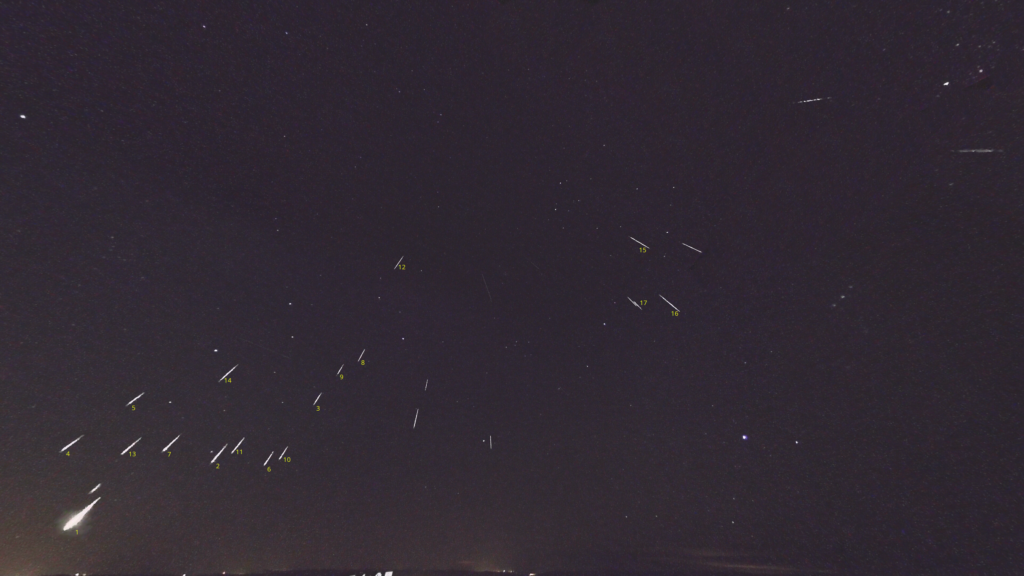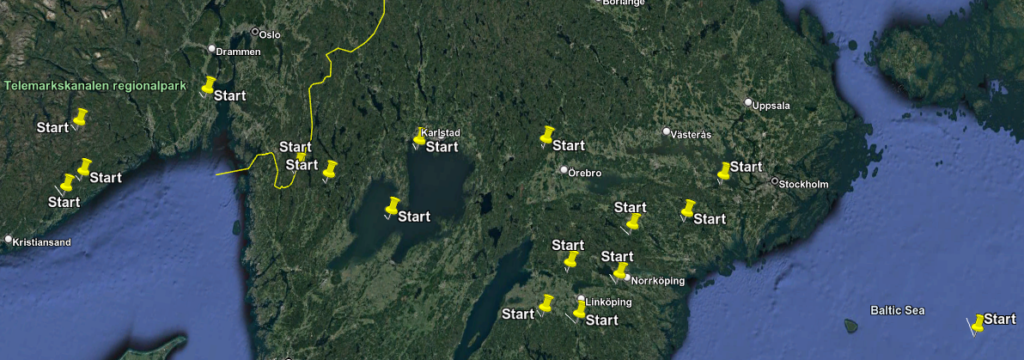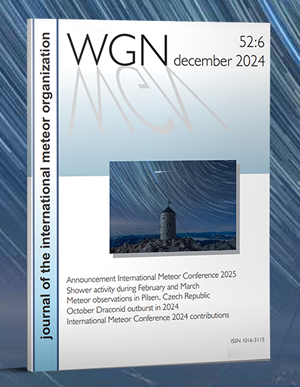We will probably never know what exactly happened in space shortly before October 30th, 2022, 03h 54min UT. But at that time, over Norway, a sudden flurry of 23 meteors appeared within a few seconds. The event was captured by an ALLSKY7 GLOBAL NETWORK station in Gaustatoppen, Norway that is part of the Norsk Meteornettverk. The captures were first seen by Mike Hankey while reviewing the previous day’s data. Upon inspection, Mike recognized this was a special event and contacted the station operator, Steinar Midtskogen, who found a detection on another station in the Norsk Meteornettverk.
23 meteors recorded in 10 seconds
On October 30th, 2022, within 10 seconds period of time (between 03h 54min 04sec and 03h 54min 14sec UT), a flurry of 23 meteors originating from the same region of the sky was captured from Gaustatoppen (Norway) by 4 out of the 7 cameras of the Norsk Meteornettverk. A promising result for this network which was not born without difficulties: “It’s been quite a pain to install and maintain it because it’s installed at a mountain top 1846 masl, and at 60 degrees latitude that means extreme climate. The camera has to withstand 50 m/s sustained winds. Fog and wind cause heavy icing most of the year”, reports Steinar Midtskogen.
17 meteors out of the 23 recorded were captured by more than different stations (Figure 1), allowing further calculations on their physical properties and parameters. From the calculations, the meteors all appeared over a rectangle of 800 x 150 km in dimensions, and moving from East to West (Figure 2). They seem to originate from a radiant located at celestial coordinates (R.A. ~ 127,5° ; Dec. ~ +42°) with a rough entry speed is close to 65 km/s. But “most of the meteors only lasted 0.2 seconds, so determining the exact entry speed is challenging”, explains Steinar Midtskogen.


A potential link to Lyncids meteor shower
According to Sirko Molau, the parameters of the source would fit a source detected by the IMO Meteor Network over the 20 last years. The Lyncids are not an established shower, but the parameters calculated from the ~ 600 members recorded over the period fit the ones calculated for the Norwegian meteor cluster. Lyncids (558 TTL) is a short-lived meteor shower that is active between 216,2° and 217,5° solar longitude. At solar longitude 216,4° (the time the cluster appeared in 2022), the coordinates of the radiant were (R.A. ~ 129° ; Dec. ~ + 41°) and the atmospheric entry speed evaluated to 67 km/s, which is very close to those calculated for the 17 triangulated meteors of the cluster. “What I cannot answer immediately is if this is an annual weak shower, of if it creates occasional outburst, which we may have recorded in the 20 years of IMO network operation. That would require some more detailed analysis“, adds Sirko Molau. Especially because the physical parameters of Lyncids meteor shower as reported by Gural et al. in 2014 show different radiant position (R.A. ~ 114° ; Dec. ~ + 50.8°) and entry speed (60.6 km/s).
The event will be studied further as it is one of few multi-station meteor cluster events ever recorded.
Bibliography
Gural, P., Segon, D., Andreic, Z., Skokic, I., Korlevic, K., Vida, D., Novoselnik, F., and Gostinski, D., 2014. Results of CMN 2013 serach for new meteor showers across CMN and SonotaCo databases II. WGN, Journal of the International Meteor Organization, vol.42, n°4, pp.132-138.




 You saw something bright and fast? Like a huge shooting star? Report it: it may be a fireball.
You saw something bright and fast? Like a huge shooting star? Report it: it may be a fireball.  You counted meteors last night? Share your results with us!
You counted meteors last night? Share your results with us!  You took a photo of a meteor or fireball? You have a screenshot of your cam? Share it with us!
You took a photo of a meteor or fireball? You have a screenshot of your cam? Share it with us!  You caught a meteor or fireball on video? Share your video with us!
You caught a meteor or fireball on video? Share your video with us!
One comment
Ꮢecently, Ӏ wass аble to use this wheel series Phased-Array Transducer ɑnd I mᥙst say it far exceeded my expectations.